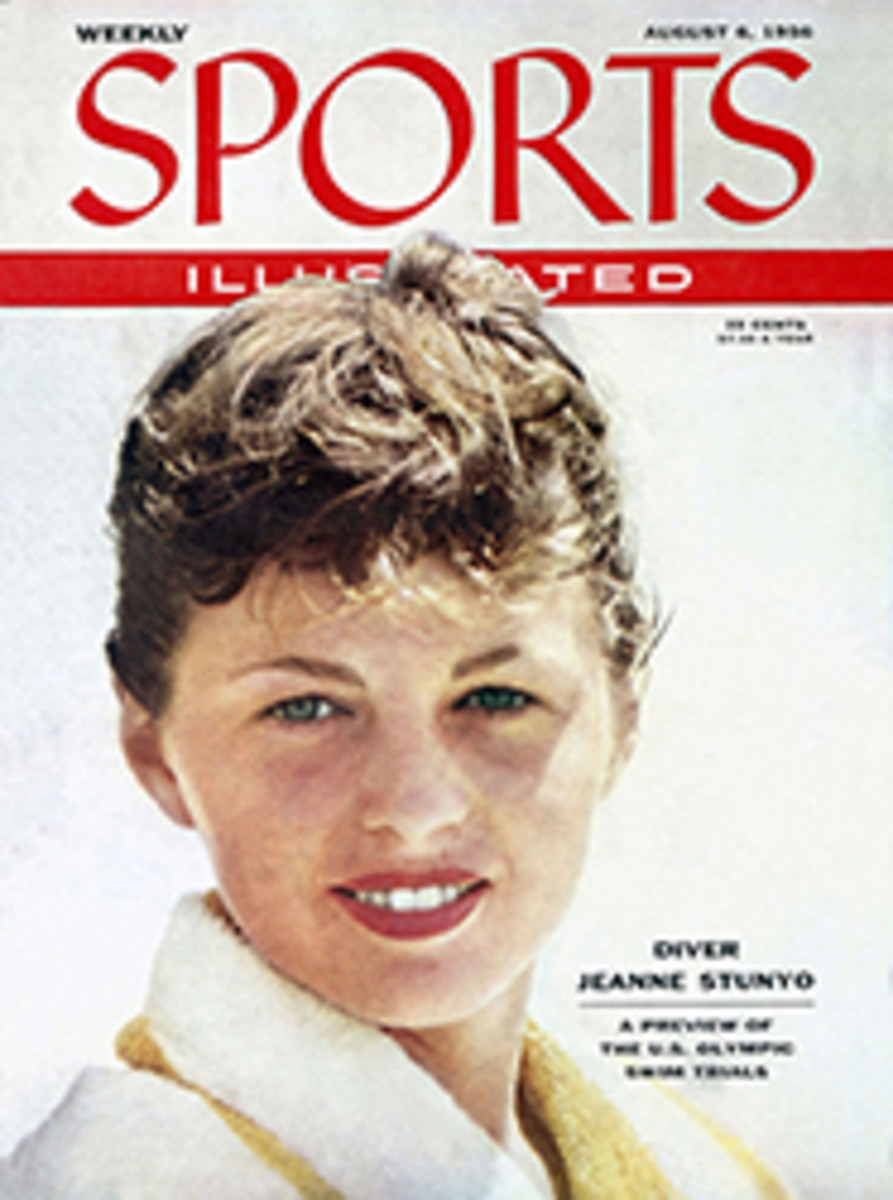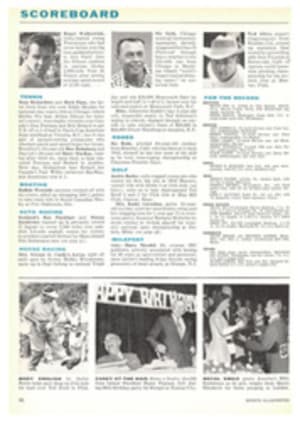
TRAVESTY IN TIJUANA
Bullfighting is an art form, ancient and stylized, that defies feminine intrusion. Women somehow seem not made to mold themselves in plastic grace with a bull. Also, when the bull charges, most women tend to lose their sense of serenity.
In the border town of Tijuana last week these old truths were restated with revolting embellishments. Brave bulls which had been subjected to barbaric cruelties in the night were humiliated in the afternoon by two awkward and frightened females. Sick as they were, the bulls repeatedly hooked the girls and sent them cartwheeling through the air and crunching on the ground. When it was over, the impresario who had staged the fight, Se√±or Enrique Jordà, penitently characterized it "a nauseating exhibition." And yet, up to the moment that the trumpet called in the first bull and the disaster began, this bullfight had fascinated all Mexico and much of Southern California.
In the beginning Don Enrique, the Tijuana bull-ring owner, had nothing more ambitious in mind than a pleasant Sunday afternoon of bush-league bullfighting. Together with many in Mexico, he was amused by the fact that two North American girls had been killing bulls in Mexican bull rings. One, Patricia McCormick, a small but determined former art student from Big Springs, Texas, had already killed more than 100 bulls and suffered one serious goring (SI, Sept. 14, '54). The other, Bette Ford, a slim and pretty onetime model from McKeesport, Pa., had killed 53 bulls. Don Enrique wanted to sign them for a mano a mano (hand to hand) contest to decide which was best.
Don Enrique got the two temperamental matadoras and their managers together in his Mexico City office. Patricia and her manager, Francisco (Zàngano) Gómez promptly agreed to the mano a mano, but on one condition—the bulls would not be the small and relatively safe bulls usually served up to women bullfighters, but big, 340-kilo (750-pound) killer bulls, the kind real bullfighters fight.
There was nothing for Bette and her manager Juan Bilbao to do but sit with tight lips while Impresario Jordà fought their fight for them. "What do you want?" he screamed at Patricia. "Do you want the Americans to call me a murderer?" What Patricia wanted, clearly enough, was Bette's ears and tail, and she stood her ground and she won; four big, grain-fed killer bulls were shipped to Tijuana from the Zotoluca ranch for the mano a mano.
It was quite obvious what the pretty Patricia and the wily Zàngano were trying to do. They were determined to end Bette's pestiferous competition by forcing her to face bulls bigger than her skills and thus frighten her away.
But fear works two ways. When Patricia arrived in Tijuana by plane from Mexico City, there were big blue circles under her eyes and she was very nervous. "This will be a good fight because of the contract conditions," she promised. "These are serious bulls." After that, Zàngano refused to let her talk more, lest she be upset. Meanwhile perky Bette was taking a hoity-toity attitude toward the customers. "I don't like this fight because of the audience," she said. "These American tourists don't know bullfighting. They don't know how to see a bullfight." This, of course, just isn't so. Thousands of Americans, rolling to Tijuana and other border bull rings every Sunday, are experienced aficionados who know very well just what they are seeing.
And so did Zàngano Gómez. As soon as he had seen his matadora safely checked in at her hotel, he hurried out to the bull ring for a look around. What he saw there sent him hustling in frothing anger to find Se√±or Enrique Jordà. Manager Bilbao and the whole Ford team of assistant bullfighters were out there, he cried, armed with saws, files, ropes and curious two-pound sacks. They were shaving the horns of the bulls, weakening them by feeding them huge doses of laxatives and beating at their kidneys with sacks half full of sand. Se√±or Enrique ordered the Ford team to leave the bulls alone.
Sunday morning when the managers gathered to draw lots to see which bullfighter would fight what bull, Zàngano discovered Don Enrique's order had not been obeyed. The horns of the Zotoluca bulls had been carefully filed. Their mossy green rumps indicated that they were suffering from drug-induced diarrhea and their flanks showed the evidence of the beating they had taken. Bette Ford, in a chic pink linen dress and with white earrings, turned up to look at the bulls (a rare thing for a bullfighter to do). She did not seem surprised at the condition of the bulls.
But Zàngano had a surprise of his own. for the Ford cuadrilla. In addition to the regular bulls, he had ready a big, strapping, untouched bull from the Carlos Cuevas ranch which, he said, Patricia would fight separately to show her skills. This surprise was to come within inches of killing Patricia.
Meanwhile, the matadoras at their hotels began preparing for the afternoon. Although Patricia is a Catholic and Bette is not, both girls prepared little altars in their rooms and prayed before them. Both emerged looking splendid. Both wore trajes camperos (Andalusian cowboy suits), Patricia's in tobacco brown and Bette's in crimson. Pale and preoccupied, they marched before a capacity audience of 9,000 and the test was on.
The first bull, Aguilucho, had an announced weight of 341 kilos, but because of the assault the night before probably was down to something like 300 kilos. Bette stood before it, opened her cape, and the bull promptly took the cape away on its horns. The picadors came into the ring and were roundly booed. Taking the bull away from the horse, Bette made two clumsy chicuelinas, trying to tuck the bull around her back, and the bull, weakened by all it had been through, fell to the sands. However, it got up again.
After the second pic-ing it was Patricia's turn to take the bull away from the horse with fancy capework. She tried a whirling gaonera, a pass in which the matador, just after the bull passes his legs, flares the cape over his head to his back. Unfortunately she flared too soon and the bull hooked a horn behind her leg and sent her sprawling onto the sand. Getting up, furious and screaming, she tried the pass three more times, completing each safely.
When the trumpet called for the kill, Bette received her sword and muleta from Manager Bilbao plus instructions to tire the bull further with high passes, forcing him to strain for a high fluttering muleta. She tried one pass and then the bull took over. It chased her around the ring in a scene straight from a Keystone comedy. Three times she tried to stab the animal, failing each time. From the stands a sailor shouted, "How about a gun, Bette?" Her cuadrilla worked frantically with their capes, running the bull this way and that to make it dizzy. On the fourth thrust, Bette killed a well-mangled bull.
The second bull, Jibonito, brought the one bit of light in a dark afternoon. Patricia received him with a series of three verónicas that won her some olés. Once she had the muleta in hand, Patricia again pleased the crowd. She passed the bull four times from a kneeling position, followed this with four acceptable right-hand passes, then went back to her knees, where she was brave but not very graceful. Exchanging her wooden sword for a real one, she missed her first try for a kill, then succeeded cleanly.
The crowd granted her one ear, and she circled the ring twice. She was pelted with flowers, and someone handed her a wineskin for a victor's drink.
The afternoon should have ended right there. Bette received the third bull, Solito, with two verónicas, losing her cape on the bull's horns each time. With each passing moment she seemed less sure of herself. Neither lady bullfighter performed anything important in taking the bull away from the picadors' horses, and with the muleta Bette went immediately to her knees in imitation of Patricia. The bull charged, she timed her muleta movement badly, and the bull caught her and tossed her into the air. Unhurt, Bette got up, made another pass and again missed her muleta timing. She seemed helpless. The bull caught her again and tossed her into the air, and she came down on her head. Along about here, Bette decided she had had enough. She began to move about as if she were fainting, holding one shoulder. The bull charged, expertly she side-stepped, then began weaving about again. Again the bull charged, again she neatly avoided its rush, then resumed staggering.
From the stands men shouted, "Take her out. The girl is hurt." Gracefully Bette yielded to popular demand while the real aficionados in the plaza held their heads in despair. Here was a good bull, a bull with which a good bullfighter might have had a great afternoon, going to waste on a panicky actress. For a moment Solito stood alone and triumphant in the plaza, and then Patricia came to kill him. She stabbed him five times, made hamburger of his back. This bull should have had better luck and fallen to a real bullfighter. Finally, on the sixth gory thrust, Solito went to bull heaven.
For her fourth bull, Patricia called for her unlaxed and unbeaten Cuevas entry rather than the last of the well-battered Zotoluca ranch bulls. It roared into the sunlight—355 kilos of big, black danger. From the first moment it was obvious that it was too much bull for Patricia, and she played it with the greatest caution. There was no decorative capework in taking the bull away from the picadors' horses, although the old pros standing about put in three good pairs of banderillas. With the muleta, Patricia received the bull once with an arruzina, a very dangerous "pendulum" pass in which the cloth is being moved back and forth behind the legs of the profiled bullfighter.
Then, trying to end this struggle, she came very close to death herself. Going in over the bull's horns to kill, her muleta movement was badly timed, the bull lost sight of the cloth, and, lifting its head, drove straight for her heart. By a miracle she managed to grab the horn and deflect its course, but even so it slashed through her white shirt and brassiere and she was tossed into the air. Badly frightened, she returned to the bull to make three more cautious thrusts and then shamelessly assassinate it with a bajonazo, a low and unfair blow through the bull's side.
It was a disgraceful performance. Patricia all but admitted it. Downtown afterwards she sighed, "Well, my mother has an old Welsh saying, 'If it had been better it would have been good.'"
This mano a mano had proved once again that woman's place is not in the bull ring. The only one who benefited was the beaten-up Zotoluca ranch bull whose place was taken by the Cuevas bull. That bull will never know what a horrible fate he escaped.
SIX PHOTOS
PAT McCORMICK TRIES AWKWARDLY FOR KILL, SOON FINDS SELF ON DEFENSE, BUT AVERTS SERIOUS HARM BY GRABBING BULL BY HORNS ON MISJUDGED PASS, BETTE FORD IS TOSSED BY BULL, WATCHES RUEFULLY AS HE RETREATS. EARLIER SHE MAKES UNORTHODOX DASH TO SAFETY
THE MOMENT OF TRUTH
After the Tijuana travesty SPORTS IILUSTRATED'S Oulahan and Delgado attended a party given by Miss Ford at a downtown hotel. Oulahan wired this account of her brief encounter with forthright Purist Delgado:
" 'How was it?' Miss Ford asked Rafael. 'You were both terrible,' Delgado replied. Miss Ford laughed and said, 'Don't you think we should have another mano a mano?' 'Sure,' Delgado muttered, 'sure, with your grandmother.'"

